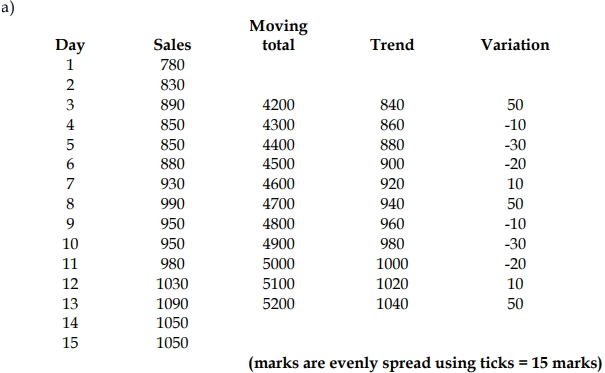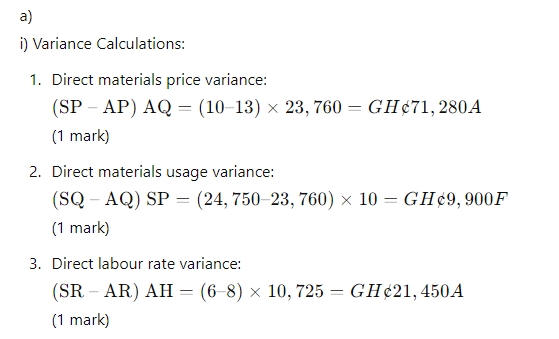- 20 Marks
Question
Slab Processes (Ghana) Limited manufactures a single product. The product is manufactured in a single process, by combining three raw materials, A, B, and C.
For 2019, the standard cost of a litre of the product was established in the budget as follows:
| Material | Quantity (litres) | Price per litre (GH¢) | Standard cost (GH¢) |
|---|---|---|---|
| A | 0.7 | 2 | 1.4 |
| B | 0.4 | 4 | 1.6 |
| C | 0.1 | 8 | 0.8 |
| Total | 1.2 | 3.8 | |
| Loss in process | -0.2 | ||
| Standard cost per litre of output | 1.0 | 3.8 |
During one month in the year, 2,000 litres of finished products was the output from the process, and the actual direct material costs were as follows:
| Material | Quantity (litres) | Cost (GH¢) |
|---|---|---|
| A | 1,340 | 2,970 |
| B | 910 | 3,450 |
| C | 240 | 1,900 |
| Total | 8,320 |
Required:
a) Calculate the material price variance and the material usage variances for the period. (5 marks)
b) Analyze the operational usage variance into a materials mix and a materials yield variance. (6 marks)
c) Comment on the significance and usefulness of a materials mix and a materials yield variance, for management control purposes. (3 marks)
d) Describe briefly THREE (3) fundamental weaknesses in the traditional annual budgeting approach that exist regardless of the budgeting method that is used. (6 marks)
(Total: 20 marks)
Answer
a) Materials usage variance
| 2,000 units of output: | Should use (litres) | Did use (litres) | Usage variance (litres) | Standard cost per litre (GH¢) | Usage variance (GH¢) |
|---|---|---|---|---|---|
| Material A | 1,400 | 1,340 | 60 (F) | 2 | 120 (F) |
| Material B | 800 | 910 | 110 (A) | 4 | 440 (A) |
| Material C | 200 | 240 | 40 (A) | 8 | 320 (A) |
| Total usage variance | 640 (A) |
(2.5 marks)
Materials price variance
| Should cost (GH¢) | Did cost (GH¢) | Price variance (GH¢) |
|---|---|---|
| 1,340 litres of A | 2,680 | 2,970 |
| 910 litres of B | 3,640 | 3,450 |
| 240 litres of C | 1,920 | 1,900 |
| Total price variance |
(2.5 marks)
Alternatively:
Material price variance = (SP – AP) * AQ
A: (2 – 2.216) * 1340 = 289.44 (A)
B: (4 – 3.791) * 910 = 190.19 (F)
C: (8 – 7.92) * 240 = 19.20 (F)
Total price variance: GH¢80.05 (A)
b) Mix variance
| Material | Actual usage (litres) | Standard mix of actual total usage (litres) | Mix variance (litres) | Standard cost per litre (GH¢) | Mix variance (GH¢) |
|---|---|---|---|---|---|
| A | 1,340 | 1,452.5 | 112.5 (F) | 2 | 225 (F) |
| B | 910 | 830.0 | 80.0 (A) | 4 | 320 (A) |
| C | 240 | 207.5 | 32.5 (A) | 8 | 260 (A) |
| Total mix variance | 355 (A) | 805 (A) |
(3 marks)
Yield variance
| Litres |
|---|
| 2,000 litres of output should use (× 1.2) = 2,400 |
| Did use = 2,490 |
| Yield variance in litres = 90 (A) |
| Standard cost per litre of input (GH¢3.8 / 1.2) = 3.1667 |
| Yield variance in GH¢ = GH¢285 (A) |
(3 marks)
Alternatively:
Material yield variance:
1.2 litres of A, B & C are used to produce 1 litre.
Therefore, 2490 litres should produce 2075 litres.
But 2490 litres produced 2000 litres.
Giving a variance of 75 litres @ GH¢3.8 = GH¢285 (A)
c) A materials mix and yield variance can be useful for control purposes when several materials are mixed together in a process, and the mix of the materials is controllable by the manager responsible for the process. An adverse mix variance indicates that the mix of materials has been more expensive than the standard mix.
If the mix of materials is controllable, there is little information value in calculating the usage variance of each individual material. Instead, it is appropriate to calculate a yield variance for all the materials in total. A yield variance should be of control value, on the assumption that the quantities of materials used are controllable – for example, management should be able to control waste or scrap levels.
(3 marks)
d) The annual budget model has several inherent weaknesses. These exist no matter what approach to budgeting is used.
- One-Year Period: The budget is for a one-year period. Targets are set for the 12 months, and actual performance is measured on the basis of achievements in one year. However, to achieve strategic change, planning needs to be for the longer term, and performance should be measured by progress towards longer-term objectives as well as shorter-term achievements. The annual budget is not compatible with longer-term planning.
- Focus on Financial Discipline: The annual budget is also seen as a system for imposing financial discipline and control. This focus on financial targets and cost control is not compatible with setting corporate objectives, where external factors and competitiveness are just as important as internal efficiency and financial returns.
- Internal Focus: The annual budget focuses on internal efficiency and improvements and lacks an external focus. However, strategic objectives and strategic planning have to take account of external factors as well as internal efficiency.
- Management Time: It can be argued that the annual budget process adds little value and is unnecessary. It wastes management time, as management should be doing other things to add value and contribute to the entity’s objectives.
- Rigid Targets: There is also an argument that the annual budget is too rigid and discourages change once the budget targets have been agreed. Management will focus their attention and efforts on achieving the agreed targets, even though circumstances might change, and the budget targets might no longer be the most appropriate.
- Compromises: In theory, the budgeting process should help management to identify 12-month objectives that are in the best interests of the entity and that will help it to achieve its longer-term objectives. In reality, however, budgeting is often a ‘battle’ between managers for resources and status. Budget targets are often the result of negotiated compromises rather than rational decisions.
(Any 3 well-explained points @ 2 marks each = 6 marks)
- Topic: Standard Costing and Variance Analysis
- Series: MAY 2020
- Uploader: Dotse


